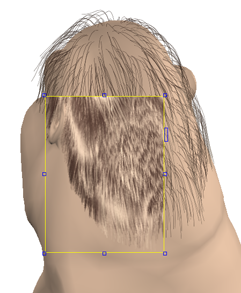There are different ways to determine the number of hairs that are rendered. The basis for determining the number of hairs rendered is theTotal Hairs parameter. Once you've set this, you can choose which percentage of this to display (see To view render hairs ) or render (see Rendering a Percentage of Hairs). As well, you can increase the number of render hairs created by using a Strand Multiplier value (see Removing Render Hairs (Density)).
The Total Hairs parameter in the Render Settings area of the Hair property editor is the total number of render hairs shown for the hair object. The higher the value, the more hair, but with slower interaction and render time. Depending on the look you need to achieve, you could reduce the overall number of hairs and instead increase the root and/or tip thickness. Using a slight kink or frizz can also help in giving the illusion of more hair.
Also, the size of the hair emitter object makes a difference: 50,000 hairs over a small object is quite densely hairy, but the same amount over a large model looks much sparser.

The slider goes only to 50,000, but you can type in values higher than this.
The default value of 6500 hairs gives you enough hair for a decent preview while styling without slowing down the interaction too much. However, for final previewing and rendering, you will probably want to use a value much higher than this for a full head of hair (such as 100,000 or more).
The Render Hairs % parameter for the Render Settings looks at the Total Hairs value and then uses a percentage of that to determine the number of hairs to draw when rendering, either in the render region or to file. Typically you would use 100% for the final render, but you can decrease this value to get a rough idea of the final result for quicker render tests.
The Render Hairs % parameter in the Display Settings (see Viewing the Hairs) does the same thing as this parameter, but is only for viewing: this is not what is rendered in the region or to file.

100% of 6,500 render hairs are rendered (in render region), while only 10% of the render hairs are displayed for viewing in the viewport.
 Except where otherwise noted, this work is licensed under a Creative Commons Attribution-NonCommercial-ShareAlike 3.0 Unported License
Except where otherwise noted, this work is licensed under a Creative Commons Attribution-NonCommercial-ShareAlike 3.0 Unported License